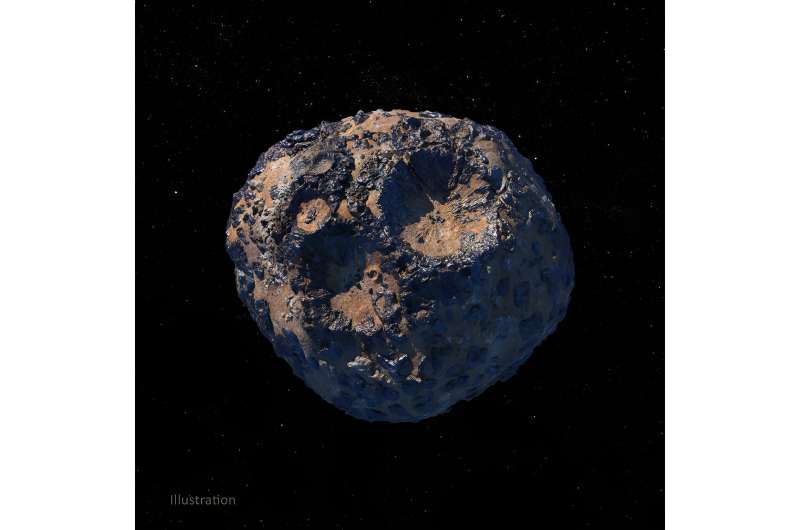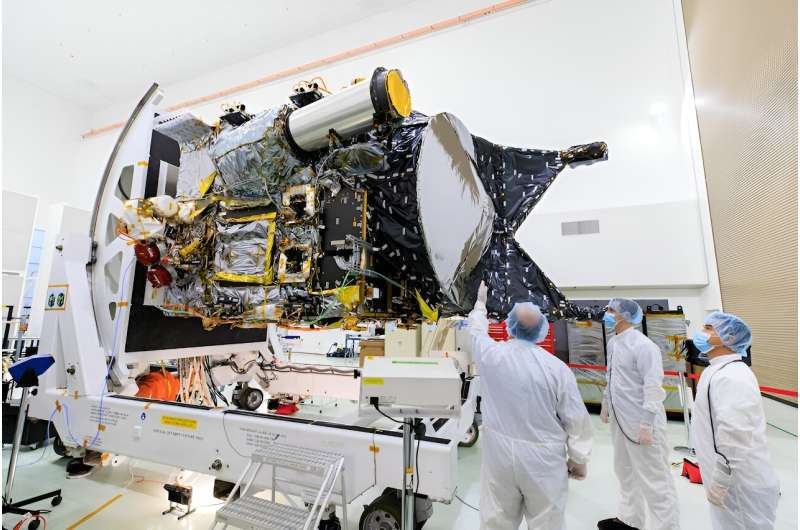NASA's Psyche mission to a metal world may reveal the mysteries of Earth's interior

French novelist Jules Verne delighted 19th-century readers with the tantalizing notion that a journey to the center of the Earth was actually plausible.
Since then, scientists have long acknowledged that Verne's literary journey was only science fiction. The extreme temperatures of the Earth's interior—around 10,000 degrees Fahrenheit (5,537 Celsius) at the core—and the accompanying crushing pressure, which is millions of times more than at the surface, prevent people from venturing down very far.
Still, there are a few things known about the Earth's interior. For example, geophysicists discovered that the core consists of a solid sphere of iron and nickel that comprises 20% of the Earth's radius, surrounded by a shell of molten iron and nickel that spans an additional 15% of Earth's radius.
That, and the rest of our knowledge about our world's interior, was learned indirectly—either by studying Earth's magnetic field or the way earthquake waves bounce off different layers below the Earth's surface.
But indirect discovery has its limitations. How can scientists find out more about our planet's deep interior?
Planetary scientists like me think the best way to learn about inner Earth is in outer space. NASA's robotic mission to a metal world is scheduled for liftoff on Oct. 5, 2023. That mission, the spacecraft traveling there, and the world it will explore all have the same name—Psyche. And for six years now, I've been part of NASA's Psyche team.
About the asteroid Psyche
Asteroids are small worlds, with some the size of small cities and others as large as small countries. They are the leftover building blocks from our solar system's early and violent period, a time of planetary formation.
Although most are rocky, icy or a combination of both, perhaps 20% of asteroids are worlds made of metal, and similar in composition to the Earth's core. So it's tempting to imagine that these metallic asteroids are pieces of the cores of once-existing planets, ripped apart by ancient cosmic collisions with each other. Maybe, by studying these pieces, scientists could find out directly what a planetary core is like.
Psyche is the largest-known of the metallic asteroids. Discovered in 1852, Psyche has the width of Massachusetts, a squashed spherical shape reminiscent of a pincushion, and an orbit between Mars and Jupiter in the main asteroid belt. An amateur astronomer can see Psyche with a backyard telescope, but it appears only as a pinpoint of light.
About the Psyche mission
In early 2017, NASA approved the US$1 billion mission to Psyche. To do its work, there's no need for the uncrewed spacecraft to land—instead, it will orbit the asteroid repeatedly and methodically, starting from 435 miles (700 kilometers) out and then going down to 46 miles (75 km) from the surface, and perhaps even lower.
Once it arrives in August 2029, the probe will spend 26 months mapping the asteroid's geology, topography and gravity; it will search for evidence of a magnetic field; and it will compare the asteroid's composition with what scientists know, or think we know, about Earth's core.
The central questions are these: Is Psyche really an exposed planetary core? Is the asteroid one big bedrock boulder, a rubble pile of smaller boulders, or something else entirely? Are there clues that the previous outer layers of this small world—the crust and mantle—were violently stripped away long ago? And maybe the most critical question: Can what we learn about Psyche be extrapolated to solve some of the mysteries about the Earth's core?

About the spacecraft Psyche
The probe's body is about the same size and mass as a large SUV. Solar panels, stretching a bit wider than a tennis court, power the cameras, spectrometers and other systems.
A SpaceX Falcon Heavy rocket will take Psyche off the Earth. The rest of the way, Psyche will rely on ion propulsion—the gentle pressure of ionized xenon gas jetting out of a nozzle provides a continuous, reliable and low-cost way to propel spacecraft out into the solar system.
The journey, a slow spiral of 2.5 billion miles (4 billion km) that includes a gravity-assist flyby past Mars, will take nearly six years. Throughout the cruise, the Psyche team at NASA's Jet Propulsion Laboratory in Pasadena, California, and here at Arizona State University in Tempe, will stay in regular contact with the spacecraft. Our team will send and receive data using NASA's Deep Space Network of giant radio antennas.
Even if we learn that Psyche is not an ancient planetary core, we're bound to significantly add to our body of knowledge about the solar system and the way planets form. After all, Psyche is still unlike any world humans have ever visited. Maybe we can't yet journey to the center of the Earth, but robotic avatars to places like Psyche can help unlock the mysteries hidden deep inside the planets—including our own.
This article is republished from The Conversation under a Creative Commons license. Read the original article.![]()
No comments:
Post a Comment